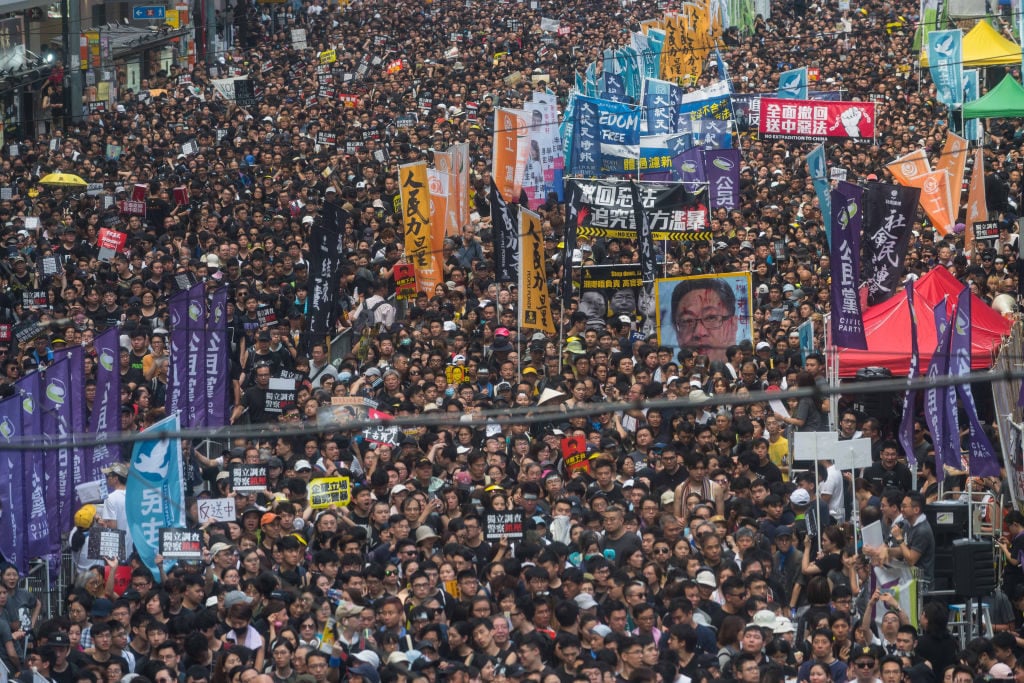Every Monday morning, artnet News brings you The Gray Market. The column decodes important stories from the previous week—and offers unparalleled insight into the inner workings of the art industry in the process.
This week, zooming out from national chaos to the global art market…
THE CENTER WON’T HOLD
Over the past seven days, political brinkmanship pushed the world’s three largest art markets closer to shared peril. Together, the events should remind us that cultural exchange all too often depends on political interests—and not the other way around.
First up: Hong Kong. The special administrative region is now entering its fourth month of mass protests sparked by a bill that would allow residents facing criminal charges to be extradited to mainland China. The situation escalated again on Thursday, when police banned a previously approved weekend rally to commemorate Beijing’s 2014 rejection of universal suffrage for Hong Kongers—the decision that sparked the Umbrella Movement.
Authorities arrested key pro-democracy activists on Friday in further hopes of muting an unauthorized demonstration. Still, hundreds of protesters took to the streets in defiance of the state on Saturday, in some cases meeting tear gas and police truncheons with bricks and firebombs, before hundreds more activists re-occupied Hong Kong’s airport on Sunday.
According to Keith Bradsher of the New York Times, officials claimed that more than 900 protesters have been arrested this summer, and that China remains committed to ignoring all of the opposition’s formal demands. Those demands include the withdrawal of the extradition bill, the establishment of universal suffrage, and an investigation into police brutality. Bradsher concludes that “the price of the strategy could be months of acrimony, possibly stretching into 2020.”
As Vivienne Chow wrote in the Art Newspaper, that scenario could undermine Hong Kong’s slate of major fall auctions, which begins at Sotheby’s and China Guardian in the first week of October. It could also endanger Art Basel Hong Kong in March 2020, to say nothing of chilling business for the district’s galleries in the many months between now and then, as Barbara Pollack reported in ARTnews.
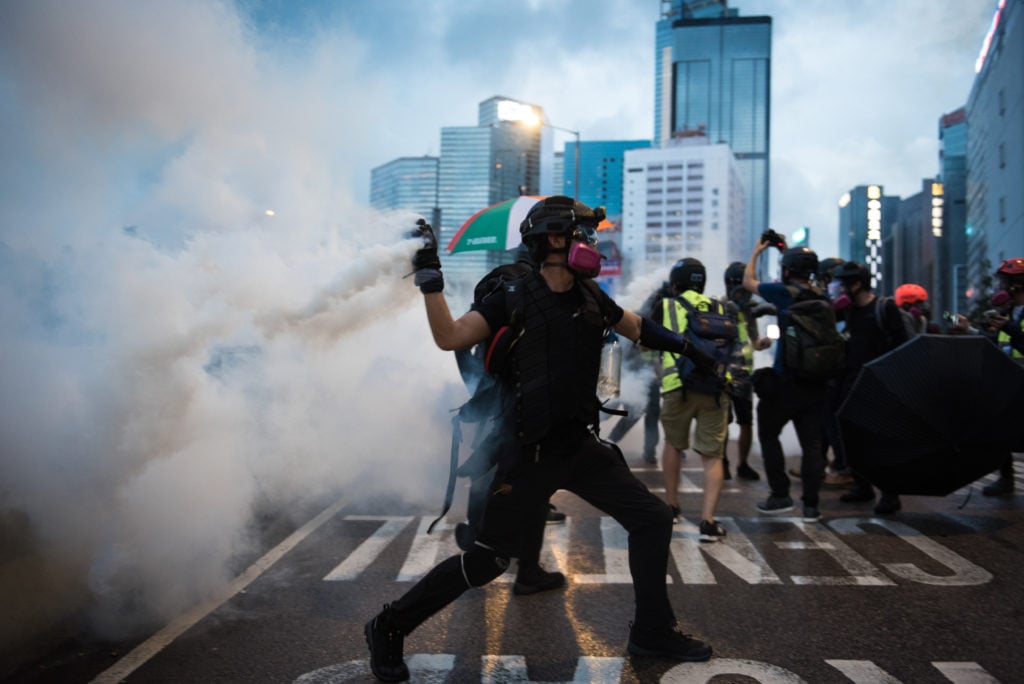
A protester in Hong Kong throws back a tear-gas round at police during an unauthorized demonstration on the fifth anniversary of the denial of universal suffrage to Hong Kongers by the Chinese state. (Photo by Aidan Marzo/SOPA Images/LightRocket via Getty Images)
Another relationship with mainland China threatened the trade in a different way this week, as my colleague Eileen Kinsella covered the Trump Administration’s decision to boost the proposed tariff on Chinese art and antiquities from 10 percent to 15 percent beginning September 1.
In Kinsella’s story, Peter Tompa, executive director of the Global Heritage Alliance, points out that any American dealer would have to pay the tariff up front to even consign works from China—likely an expense only the wealthiest sellers could stomach. This is just one reason that, after the original 10 percent tariff was announced in June, he argued it could “drive many of China’s American competitors out of business and further redirect sales to Chinese dealers serving a mostly Chinese clientele.”
The UK art market didn’t escape chaos last week, either. Wednesday brought news that newly appointed prime minister Boris Johnson would suspend parliament for five of the seven weeks preceding the October 31 Brexit deadline. Achieved through a procedure known as “proroguing,” the action will—barring pushback from the courts—leave Parliament precious little time to craft legislation that could prevent the UK from crashing out of the European Union without a deal.
As Anna Brady and Anny Shaw captured in the Art Newspaper, any potential longer-term benefits of that outcome for the British art market, such as the possible elimination of import taxes on art and antiquities, would be offset to no small degree by a short-term avalanche of shuttered ports, stymied customs and immigration agents, and escalated logistical costs.
Lurking in the background, too, is the specter of Paris capitalizing on London’s confusion to reclaim its former centrality to the European art market—a still-remote prospect nevertheless made at least slightly more plausible by David Zwirner’s decision to open a permanent space there for want of a “European gallery” instead of just a “British gallery.”
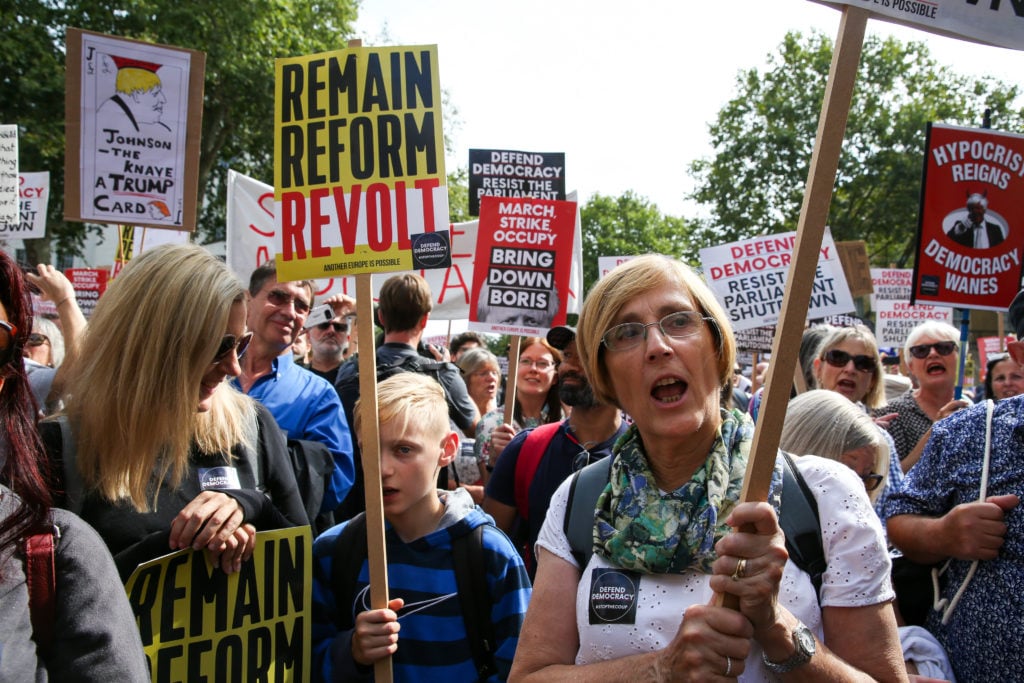
Protesters outside Downing Street in London demonstrate against British Prime Minister Boris Johnson’s plans to suspend UK parliament for five of the seven weeks before the UK is set to leave the EU. (Photo by Steve Taylor/SOPA Images/LightRocket via Getty Images)
THE BIG PICTURE
It’s standard, and important, to analyze each of these art-market ruptures in isolation. But what do we do with them in totality?
Without a doubt, we should begin by recognizing that the state of the art market is only a sideshow in these events.
According to Bradsher of the Times, activists in Hong Kong have been attacked with “sticks, baseball bats, and even meat cleavers” for pursuing democracy. True to form, Trump seems to have no coherent plan whatsoever in his trade war with China, especially now that he’s realized it could tip the US economy into recession—an outcome that would cost thousands of jobs, force scores of everyday people to make impossible choices about how to get through the hard times, and potentially torpedo his re-election chances in 2020.
Much of the same economic strife could descend on a post-Brexit UK, too, with the added human cost of untold numbers of families being broken up and lives disrupted by the implementation of even more restrictive immigration policies (to say nothing of the potential for violence by xenophobic thugs emboldened by the far-right’s most widescreen political triumph yet).
These are the places our thoughts and, hopefully, actions should go first.
Afterward, though, it is worth taking stock of how these unsettled (and unsettling) times affect the international cultural landscape, and not just for those of us whose careers and livelihoods depend on its health.
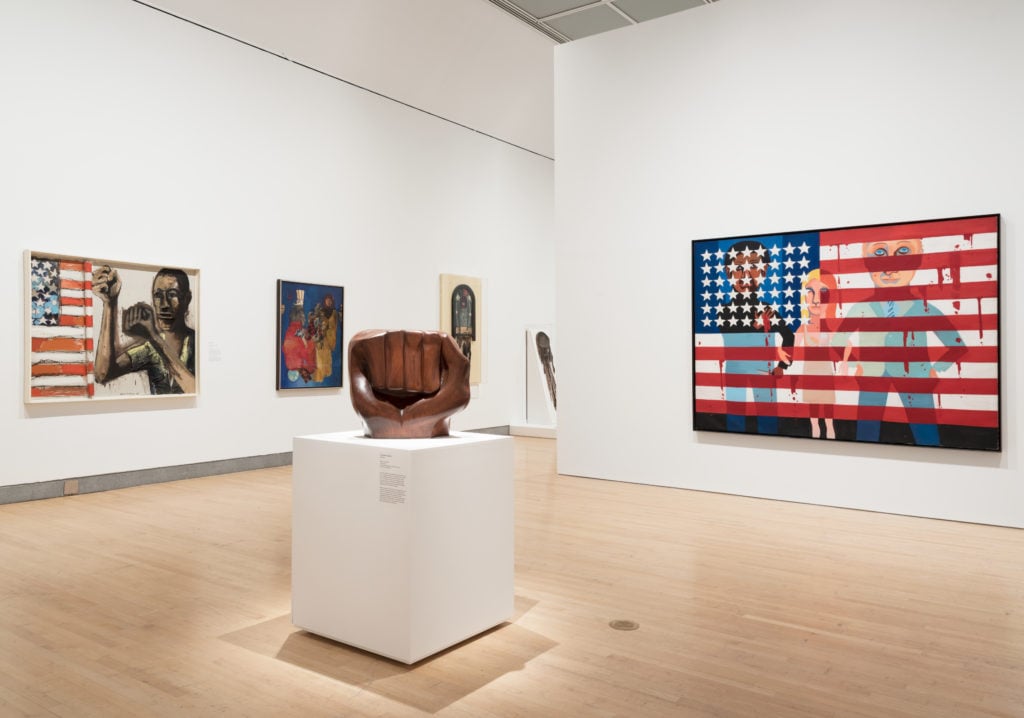
Installation view, “Soul of a Nation: Art in the Age of Black Power” at the Brooklyn Museum. Photo: Jonathan Dorado, Brooklyn Museum.
Although they are certainly not the only factors—the internet, and technology more generally, are frantically waving their hands for attention here—more open, progressive trade and immigration policies have been two of the main drivers of cultural progress in the arts during my lifetime. And it’s worth remembering that these paradigms have been helping to enlighten the world for hundreds of years, whether we’re talking about the secondary effects of maritime shipping or the Silk Road (the literal one, not the dark-web marketplace).
Think about how much intra-art-world progress museums, collectors, dealers, and educators have made toward recognizing the importance of artists who live(d) and work(ed) outside the traditional geographical, ethnic, and gender boundaries of the old western canon in recent decades. Just as importantly, think about how much the greater exposure of this work has contributed toward raising awareness, if not consciousness, of the conflicts and experiences animating these artists’ lives among minds outside the art world. From “Radical Women: Latin-American Art, 1960–1985” to “Soul of a Nation: Art in the Age of Black Power,” from museums deaccessioning the work of old white men to fund more diverse acquisitions to the market gravitating in the same direction on its own, this theme is emerging everywhere (even if not at the ideal speed).
Do we get as many of these gains without the growth of true global markets for all kinds of goods and services creating the broadest geographical base of wealthy buyers in history over the past 40 years? (Remember, a big part of the reason so many young talents have been elevated, and so many under-appreciated artists have been rediscovered, is that demand from new buyers and newly founded institutions for high-quality artworks outstripped the supply of works by the status-quo greats.) Can we expect these same gains if buyers, sellers, artists, curators, and educators aren’t able to easily travel, relocate, or set up nonprofit and for-profit businesses across the borders of new and developing economies alike during the same stretch of time?
The answer is unequivocally “no.”
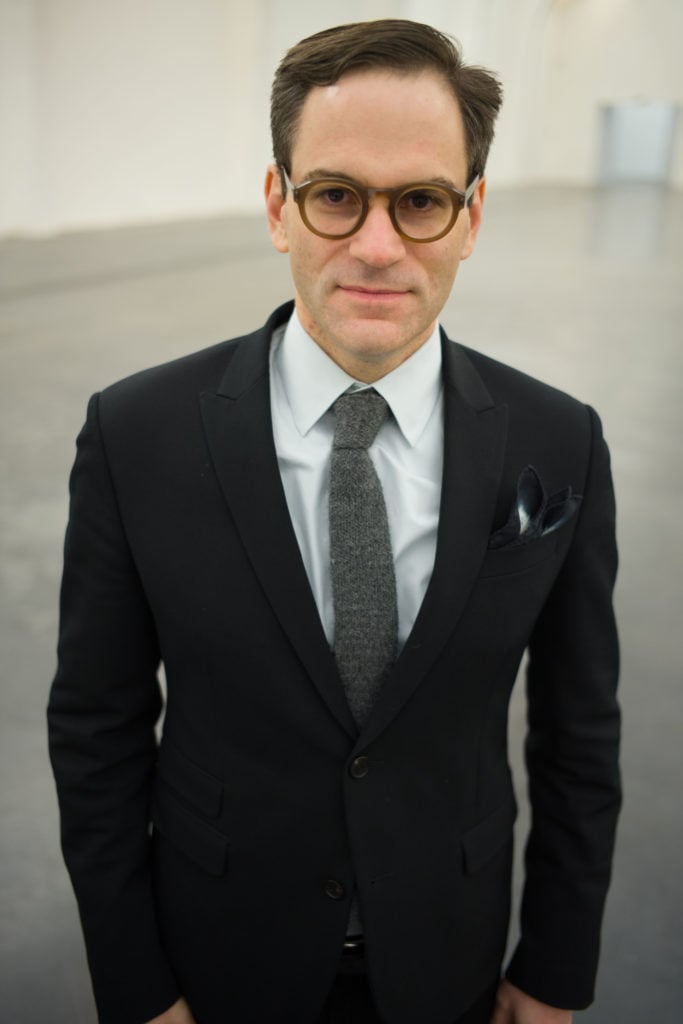
UCCA director Philip Tinari. Photo courtesy of the UCCA.
TRADE SECRETS
One specific example from this week drives the point home. Philip Tinari, the director of Beijing’s UCCA Center for Contemporary Art, mentioned in an interview with artnet News editor-in-chief Andrew Goldstein that “Picasso: Birth of a Genius,” the first-ever grade-A blockbuster museum show of Picasso to reach China, only happened because Beijing officials were willing to—irony of ironies, vis-à-vis Trump’s trade war—waive a tariff on imported artwork.
That tariff would have required the UCCA to pay an untenable €200 million customs deposit to keep so many high-value works inside the People’s Republic, even though none were going to be offered for sale. It’s the type of detail no one but a wonk like me cares about… until, say, a potentially game-changing cultural event collapses because higher-ups are willing to make it a casualty of a larger economic assault.
The positive outcomes I’ve referenced represent the cosmopolitan dream of the art world in action. They prove that commercial exchange can be cultural exchange, and that people allowed to move freely between nations can enrich the communities they join just as much as the inverse.
By no means am I proposing these benefits automatically materialize from international trade and migration. But if authoritarian states crack down on their people, if trade wars erupt, if borders open mainly to push people out rather than to welcome them in, these transformative cultural gains have no chance to materialize. Everyone becomes poorer outwardly and inwardly.
Political realities around the world are threatening to puncture the bubble of the “global art market” after it’s had only a few years to take shape. I doubt the damage will be permanent. But it won’t just be to people’s bank accounts, and there’s no telling how long it will all take to repair.
That’s all for this week. ‘Til next time remember: Hope floats, but reality bites.
